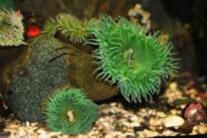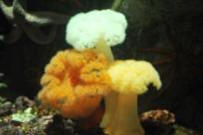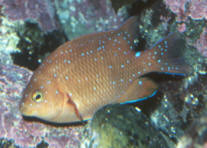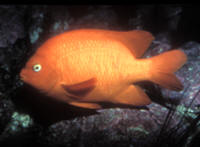|
Related FAQs: Cool./Cold Marine Systems,
Chillers/Chilling & FAQs, FAQs 2, &
FAQs on: Cool./Cold Marine Set-Up, Cold/Cool Water System Filtration,
Cold/Cool Water System
Skimmers, Cold/Cool Water System
Lighting, Cold/Cool Water System
Stocking, Cold/Cool Water System Maintenance
& FAQs on: Chiller Rationale/Use, Selection, DIY, Installation, Maintenance, Fans For Cooling, Troubleshooting, & FAQs on: Coldwater
Sharks, Leopard Sharks,
Heterodontus, Fish-Only Marine Set-ups,
Fish-Only Marine Systems
2, FOWLR/Fish and Invertebrate
Systems, Reef Systems, Small Systems, Large
Systems, Marine
System Plumbing, Biotopic presentations,
Related Articles: Marine
Planning, Getting Started with a Marine Tank By
Adam Blundell,
MS, Coldwater Sharks, Leopard Sharks, Port Jackson Sharks, Fish-Only Marine Set-up, FOWLR/Fish and Invertebrate Systems,
Reef Systems, Small Systems, Large
Systems, Plumbing Marine Systems, Refugiums, Moving Aquariums, Marine Biotope, Marine Landscaping, Fishwatcher's
Guides, Controllers,
Setting Up a California/Pacific
Coldwater Aquarium
|
 |
|
By Bob Fenner
|
A tasty rockfish at SIO's Birch
Aq. |
The
more you look, the more there is to see. This certainly applies to the
myriad possibilities of marine aquarium systems possible to us as
aquarists. Biotopes of varying current, lighting,
food-availability-make-up; specialty tanks emphasizing one species or a
group like SPS or Leather Corals; full-on breeding rigs for producing
specific algae, invertebrates and fishes Whats often left out of
discussion are non-tropical possibilities; yes, cool to cold-water
set-ups. After all, the majority of the worlds oceans are decidedly NOT
tropical. Whats more, living in the United States, we have two coasts
to choose from with a plethora of life forms to enjoy and study
occupying them. Here well explore the basics of what it takes to have a
local /coldwater system, including gear, set-up, livestocking, with
special note re a popular goby.
Steps to Completion:
A Plan:
How are you going to know where youre going w/o a
plan? I cant emphasize enough how important it is to study up, gather
data, other folks input before starting actual purchase of gear with
coldwater systems. IF your tank is not matched to the chiller,
filtration, circulation, lighting you will fail. So, the place to start
is what do you either want to keep species wise, or display/theme-wise
and next, what do you want to do with them/it?
Gear/Set up:
Chillin
Lets
first talk about chillers: All cool to cold water set ups require a
chilling mechanism. Even the largest volumes will drift too much
thermally w/o a thermostatically controlled device to keep your water
about the right temperature. For the majority of set-ups commercial
chillers resemble and operate something like a home refrigerator, with
a compressing pump pressurizing a coolant to make it convert from a gas
to a liquid, an area allowing for expansion and hence cooling, and some
heat exchanger providing for this loss of energy to transfer to the
circulated system water itself. The last can include drop in coils that
are inserted in tie-in sumps for the most part. And it should be
briefly mentioned that there are other types of coolers, cooling that
is employed at time, including ground/earth and other heat exchanger
technology, as well as more technical gear. These other means are for
either very large or quite small (a few tens of gallons)
systems.
Selecting a chiller is a straightforward
proposition. Happily, in the age of the internet there are quite a few
dependable websites and bulletin boards where you can query other
actual users which makes, models theyve found to be of good use
(reasonable purchase and operational cost, longevity); and all such
manufacturers have readily available selection charts, often on the Net
as well, that can be assessed to determine what size (in
fractional/horsepower) youll need considering volume of the system and
draw-down (the difference between likely highest ambient temperature
and your desired system/tank water temperature). In actually picking
out a chiller size, I encourage folks to get the next one up to give
them a bit of operational margin, as well as provide for the very real
possibility of their upgrading to a bigger volume system in future.
Your chiller needs careful placement. Like your
home fridge, the heat-dissipating coils of the unit need to be
periodically vacuumed to remove accumulating dust, and some space needs
to be left about the unit for air-circulation and the occasional need
to perhaps get in around it, maybe even remove it for servicing. Do
make sure and place the chiller near an electrical outlet w/ sufficient
spare amperage, and be aware that some units produce noticeable sound
when operating.
Cold-water Tanks:
To
save money and discount condensation, either your tank should be
especially thick-walled, or insulated. Early commercially made chilled
aquatic systems incorporated a double-paned viewing (front) panel with
a sealed in air space and purposeful desiccant (Calcium Chloride in
some cases) to absorb the water vapor twixt the panels during
construction. If you use just a stock set of specifications (strength
only) you may well be disappointed in how easily moisture builds up on
the outside panels, obscuring the view, wetting the surfaces
underneath, and perhaps most disturbing, driving up your electrical
bills from over-running your chiller.
A
regular tank can and should be insulated, and the top covered to
prevent thermal leaking. A simple approach for the sides, back and
bottom is to use a glue to attach cut sheeting of Styrofoam. These
supplies are easily sourced at large hardware stores. Similarly, any
sump/refugium employed should be covered. You may be fortunate to have
relatively low humidity in your area much of the time, but if you find
theres too much, too often a coating of condensation on the front
viewing panel, siliconing in another in front of it/ with a small layer
of CaCl2 at the bottom space may be worthwhile.
Filtration:
Filtering coldwater systems should encompass brisk water movement,
complete circulation, and a good deal of mechanical (particulate)
screening. Ive kept large systems with just multiple hang on power
filters, w/ and w/o skimmers, and using or not, any chemical filtrant/s
whatsoever. Remember, the key with these systems is keeping them cold,
not-overfeeding (which again is reduced with the temperature), and
relying on good-sized water changes as the primary means of keeping
water quality stable and optimized. Some commercial designs have
utilized pressurized filter modules, but I really dont like these for
the amount of labor involved keeping them clean, and the power/cost of
running the pumps to squeeze the water through their media.
Lighting:
Illuminating these systems does not need to be a major production like
tropical reef systems. Better to utilize some sort of middle of the
road boosted fluorescent technology than anything else that produces
too much waste heat like metal halide, unless your system is more than
a couple feet in water depth. A good idea to use timers to regulate
photoperiod, and its fine to leave the lights on ten-twelve hours a
day, given regularity.
Water:
Many
hobbyists, and even institutions located on the beach utilize synthetic
water, vs. natural. They do this for convenience, greater longevity/use
of the man-made product, and to reduce the likelihood of introducing
unwanted critters, pathogens and pollutants. Alternatively, there are
vendors of filtered natural seawater some that will deliver to your
site, and places where folks can easily drive up and fill their
containers with (sand/physical) filtered seawater for free. IF you opt
for this latter approach, I STRONGLY encourage you to adopt a strict
protocol of pre-treatment and storage of the water ahead of use. Some
folks just place it in the dark for a couple weeks, decanting the
water, leaving whatever mulm on the bottom to discard. Others utilize
chlorine/bleach as a biocide, removing this a few days later w/
dechlorinator to assure they exclude unwanted biota.
Cloze:
Amongst the challenges/joys of development as an aquarist is the
exploration of different types of systems, biotopes and the life that
can be kept in them. Coldwater systems should definitely be
experienced; for their beauty, grace and potential learning. IF you
live along a cool/er water coast, DO consider checking them out.
Sidebars
Stocking
Pacific Coldwater Tanks:
There is some good to great news re stocking these systems and some not
so great. The positive is that you can really load them up with life
compared w/ tropical tanks. This greater latitude is due to reduced
metabolic rates from depressed ambient temperature, as well as enhanced
gas solubility in such settings. The negative mentioned is a matter of
availability. There are a few specialty collectors (Quality Marine is
an L.A. wholesaler who deals with these a bit) who provide wild-caught
algae, invertebrates and fishes from the U.S. west coast. Hence, for
the most part, folks are limited to what either they can collect (not
hard to do w/ some minimal gear and licensing) or have other
friends/aquarists/fishers gather for them.
This being stated, Ill give you a glimpse of what
is here, has been proven of use:
|
Macro-Algae: There are a couple of handfuls of
local species Ive seen offered for sale in some shops in S. Cal..
Amongst the Greens (Chlorophytes) they include Codium (dead sailors
fingers), which doesnt generally do well, and the more useful Ulva
(shown below). Browns (Phaeophytes) involve a few Fucus/Fucales
species (one shown), and Reds (Rhodophytes) abound as branching
corallines (pictured) as well as very familiar encrusting forms. As
with tropicals, much of useful algae will come with healthy local
live rock, not requiring direct purchase.
|
|
  
|
|
Some Invertebrates: From time to time you can
find Pacific coast anemone species, some snails and echinoderms
offered for sale. All too infrequently theyre not labeled properly;
requiring chilled systems. Some examples: The Giant Green Anemone,
Anthopleura xanthogrammica, a few to several inches in diameter
depending on how far south to north it was collected, and the
deeper water Strawberry Anemone, Tealia lofotensis, and beautiful
genus Metridium (all pictured)
|
|



|
|
One last Cnidarian we should list is the
Corallimorph, Corynactis californica; not only a darling of coastal
public aquarium displays, but actually quite easy to keep and
culture. Oh, and there is a bunch of other stinging-celled life off
the coast, some of it, like jellies of various sorts, possibly
showing up via strobilization off your life rock; but much of this
has proven difficult to keep.
|
|

|
|
Some Mollusks sold in the ornamental trade
come from off shore California. Moon Snails (Polinices) and Bubble
Snails (Bulla) rarely live for any time in captive settings;
however cultured abalone, particularly the Black (Haliotis
cracherodii), and Red (H. rufescens), and Keyhole Limpet
(Megathura) are winners for larger systems w/ abundant algal forage
(pictured)
|
|



|
|
Of the spiny skinned life off the west coast,
most gets too large for all but the biggest (hundreds of gallons)
of hobbyist-sized systems. Of the best are genus Pisaster Seastars,
Patiria (Batstars) and the Purple Sea Urchin, (Strongylocentrotus
purpuratus)
|
|



|
|
There are more than 500 species of nearshore
marine fishes off our west coast, with most being or getting too
big, rambunctious, or just being behaviorally poorly
adapted/adaptable to captivity. Of the ones that you can buy
(collected out of Mexico, not the U.S., where its taking is
outlawed), the giant damsel called the Garibaldi is no doubt the
most desired. Juvenile and adult coloring shown. Another favorite
family of use is the livebearing Surfperches (family Embiotocidae).
There are numerous gobies, Sculpins and relatives, rockfishes and
much more that can work for fish stocking Pacific coast
Coldwater systems. My best advice is to spend some time perusing
the Web, books that detail public exhibits on display in aquariums
in the area. Also, do please see Tom Niesens work and Miller and
Leas Bulletin 157 for valuable input life here. (See
biblio.)
|
|
  
|
|
In the brief space allotted, I would also like
to mention the not-uncommon selling and keeping of two of our more
common shark species, the California Horned Shark (Heterodontus
francisci), and Leopard Shark (Triakis semifasciata). These and the
one Moray off our coast, the Green/California, Gymnothorax mordax,
are really animals for only the most experienced and dedicated of
aquarists; requiring huge volumes and considerable expense in their
keeping.
|
|


|
Stocking is done as with any captive aquatic
system; with preparation and testing to assure nitrogen cycling is
complete, in steps not to overwhelm beneficial microbial populations. I
start new systems near the high temperature-wise that Ill be keeping
them to promote the process, and place some live rock (often with all
organisms intact rather than removing macroalgae et al.) in three or
four every two-three week interval steps to allow for die-off and large
water change effects. The break in and livestocking steps entail a few
months time; definitely more than warmer water set-ups, due to the
reduced chemical/biological activity of lower temperature.
Sidebar:
About the Catalina Goby:
Though too often sold as a tropical or even cool-water species, the
Catalina Goby is decidedly cold water (50s to low 60s F.) species;
living a much shortened, tenuous period if kept in warmer water.
|
The Blue-Banded or Catalina Goby, Lythrypnus
dalli (Gilbert 1860), is a real beauty with its brilliant red body
and electric blue vertical lines. Its natural distribution is the
two California (Baja, Mexico and U.S.) Pacific coasts. Because it
is not a true tropical, it lives only a short while in water in the
70s F. Specimens collected in the summer months live a bit longer,
but rarely more than a year.
|
|

|
Bibliography/Further Reading:
Burgreen, Warren W. 1972. An inexpensive cold water aquarium. Marine
Aquarist 3(2):72.
Ellis, Gerald R. 1982. Keeping temperate marines. FAMA
6/82.
Glodek, Garrett S. 1990. Coldwater marine aquariums. FAMA
9,10/90.
Goldstein, Robert J. 1992. Cold-water aquaria; making a big splash
with consumers. Pet Age 4/92.
Miller, D.J. and R.N. Lea. 1976. Guide to the coastal marine fishes
of California:
California fish bulletin number 157
Niesen, Thomas M. 1982. The Marine Biology Coloring Book. Harper
& Row, Publishers, NY.
Robertson, Graham C. 1975. Collecting and keeping temperate marines.
Marine Aquarist 6(6):75.
Wrobel, David J. 1987. Keeping native marine fish in the home
aquarium. FAMA 12/87.
Wrobel, David. 1992. The temperate marine aquarium. TFH
6/92.
Wrobel, David. 1992. Chilling your aquarium; how to control
excessive water temperatures. AFM 12/92.
Are there any commonly available "tropical" marine fish that
actually prefer temperate 62 degree F water?
12/3/13
<Mmm; yes... Catalina gobies (Lythrypnus), Blue-spotted Jawfish...>
I live in Florida and have a nice little ten gallon planted freshwater
tank and four tropical reef tanks ranging from a 6 gallon Fluval Edge
with soft corals of various types (although my pulsing Xenia is starting
to run away in that tank....Grrr)
<Trim it back and vac regularly>
and a yasha goby with its pet/worker slave shrimp to a 30 gallon Biocube
with a variety of sps and Lps hard corals and an assortment of
aggressive fish that were carefully introduced and have been doing
"swimmingly" for a couple of years (a neon Dottyback, a yellowtail
damsel and a falco Hawkfish all of which have their own territories and
there are no squabbles (damsel high, hawk middle and dotty skulking
along the ground and in various caves I've set up) even during feeding.
So.....my question has nothing to do with the above humblebrag (which is
really just to show I have some at least limited experience in your
world). However, since then we have bought a 20 gallon coldwater
marine setup as my wife and I have spent a fair amount of time on the
Left Coast recently despite living in Florida and have seen how in the
right hands a coldwater tank can be just as beautiful (or at least
almost) as a typical tropical reef tank.
<Oh yes>
In place of corals, we have some stunning quickly growing colonies of
jewel "anemones" in the Corynactis genus (a variety that is highlighter
yellow with red tentacle tips, one that is a bright neon green with pink
tips and the more common "strawberry" variety that are pink with purple
tips) and an assortment of true anemones (plumose anemones or Metridium
genus in white, orange and a pretty rare lime green variety; a couple of
the beautiful in small doses but very common aggregating anemones
Anthopleura elegantissima; two small green moonglow or burrowing
anemones Anthopleura artemisia; a burnt orange beadlet anemone Actinia
equina; and a "true" strawberry
anemone Actinia fragacea. The tank looks
great although it's a little sparse as it will probably be 6 months to a
year or more before the Corynactis colonies grow in sufficiently to
cover the rockwork.
In addition to the true anemones and "anemones", we've got a basic
assortment of coldwater cleaner snails including the black turban snails
Tegula funebralis that are frequently seen in Florida LFS as reef
cleaners; purple olive snails Olivella biplicata;
<Just picked up a nice shell of which at Volleyball last wknd...
imported sand here in San Diego... beach to bay>
and periwinkles Littorina littorea. Other members of the cleanup
crew is a fat and healthy eccentric sand dollar/biscuit urchin
Dendraster excentricus and five micro hermit crabs supposedly in the
Pagarus genus (although one is getting much bigger than the others so
I'm keeping my eye on him in case he turns out to be too big and
aggressive). At the moment for our "display" active critters we
have a Catalina Goby Lythrypnus dalli;
<Oh!>
a fluffy sculpin Oligocottus snyderii; a stout shrimp Heptacarpus
brevirostris and a porcelain crab Petrolisthes eriomeris.
So far everything is doing well and is fat and healthy except the
plumose which refuses to come out in the daylight and a small spot prawn
and previous Catalina Goby that was living in the tank with the other
aforementioned fish. The other Catalina goby and small spot prawn
were fat, eating well and both completely disappeared with no signs of
illness, distress or aggression from other creatures. I assume
they both dove head first into one of the true anemones despite the
retailers assurance they "live with anemones and would never get
caught".
<Wrong>
My dilemma and the reason for the extensive write up is that I would
like to get more activity in the tank and miss the "free swimming" fish
I have in most other tanks. The only true coldwater fish small
enough for my tank are all bottom dwelling Sculpins and gobies or else
incredibly rare in the trade micro filefish and small lump suckers that
go for hundreds of dollars per fish. However, as I live in Florida
I can't keep the "coldwater" tank at 50-55 like they do at public
aquariums as the condensation becomes too much in an ordinary Florida
home. So I keep it at a balmy for them 62 degrees and it hasn't
seemed to noticeably affect anything (unless that's the reason for my
plumose's shyness).
Can you think of any small "tropical" fish that would be happy in 62
degrees AND not be stupid enough to dive head first in the nems?
<Mmm, well; I wouldn't add anything more to this small volume... IF you
lived locally, I might buy a fishing license, do a bit of tidepool
collecting... some small (young) Surfperches, perhaps a Girella... even
a tiny Hypsypops for a while would be fab. Bob Fenner>
Re: Are there any commonly available "tropical" marine fish that
actually prefer temperate 62 degree F water?
12/3/13
Thank you for the response. That's unfortunate as I would like
something in the top and middle portions of the tank free-swimming.
<Ah yes; many possibilities. Do you have a copy of Miller and Lea,
bulletin 157? Any of Sam Hinton et al.s works re the W. coast? BobF>
Re: Are there any commonly available "tropical" marine fish that
actually prefer temperate 62 degree F water?
12/3/13
No but I will see if I can track some down and review. Thank you.
<Ahh, I look forward to our future communications. B>

